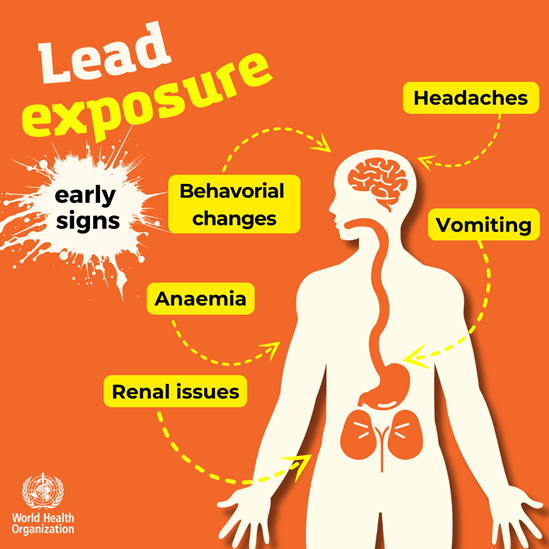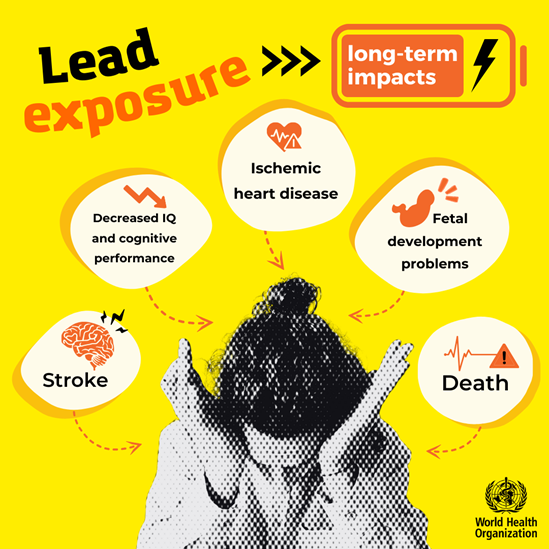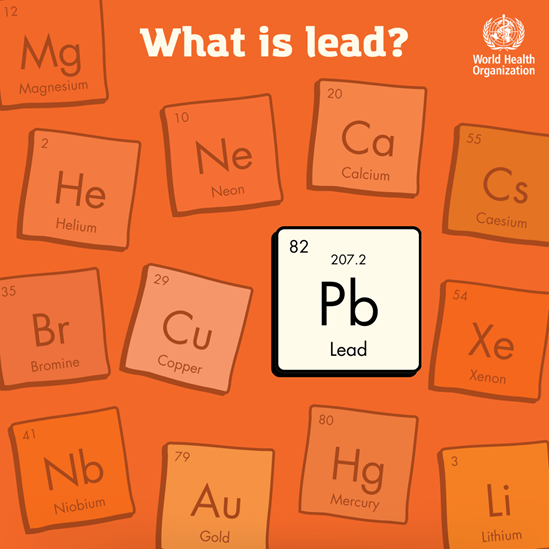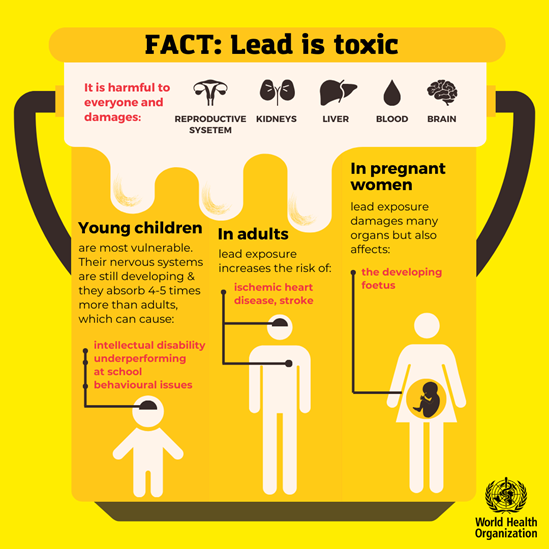.tmb-768v.jpg?sfvrsn=c35b956e_1)
Water access and safety in Vanuatu
International Lead Poisoning Prevention Week
19-25 October 2025
About the campaign
The issue
Lead is a well-recognized toxicant that has wide-ranging health impacts, in particular affecting the neurological, cardiovascular, renal, gastrointestinal and haematological systems. Young children are particularly vulnerable as they have unique pathways that can lead to higher exposures than adults. In addition, lead can lead to irreversible damage to the developing brain that may result in health outcomes that last a lifetime, such as reduced intellectual ability. The Institute for Health Metrics Evaluation’s (IHME) latest data estimate that more than 1.5 million deaths globally were attributed to lead exposure in 2021, primarily due to cardiovascular effects. Additionally, lead exposure was estimated to account for more than 33 million years lost to disability (disability-adjusted life years, or DALYs) worldwide in 2021.
Despite widespread recognition of the harmful effects of lead and actions in many countries, exposure to lead, particularly during childhood, remains a key concern for health care providers and public health officials worldwide.
Important sources of lead exposure include environmental contamination from mining, smelting, manufacturing and recycling activities, and the use of lead in a wide-range of consumer products. The majority of global lead consumption is used in the manufacture of lead-acid batteries for motor vehicles. Other products containing lead include pigments, paints, solder, stained glass, lead crystal glassware, ammunition, ceramic glazes, jewellery, toys, some common electrical and electronic items, some cosmetics such as kohl and sindoor, contaminated spices and traditional medicines used in countries such as India, Mexico and Viet Nam. Drinking water delivered through lead pipes, pipes joined with lead solder or from water system parts may contain lead.
The campaign
International Lead Poisoning Prevention Week (ILPPW) takes place annually during the third week of October. The theme this year No Safe Level: act now to end lead exposure.
The aims are:
- raise awareness about the health effects of lead exposure;
- highlight global efforts to protect children; and
- urge countries to eliminate lead paint through regulation.
Lead remains a global health threat, as a poison with wide-ranging health impacts on the brain, heart, kidneys, digestive and blood systems. Lead is especially harmful to children, who absorb far more than adults and can suffer irreversible brain damage.
The Institute for Health Metrics Evaluation’s (IHME) latest data estimate that more than 1.5 million deaths and more than 33 million years lost to disability (disability-adjusted life years, or DALYs) occurred worldwide in 2021.
Governments, civil society organizations, health partners, and other stakeholders are invited to join the campaign by using and sharing the official materials available on the campaign website. A wide range of resources is provided to support national and local activities.
Partners are encouraged to organize events, raise awareness, and register their events to showcase global action during the week.
Together, we can end lead exposure.
Hashtags: #BanLeadPaint #LeadPoisoning
Why action matters
Despite widespread recognition of the harmful effects of lead and actions in many countries, exposure to lead, particularly during childhood, remains a key concern for health care providers and public health officials worldwide.
Lead is eliminated from petrol. Yet, only 50% of countries have banned lead in paint.
Common uses of lead
The majority of global lead consumption is used in the manufacture of lead-acid batteries for motor vehicles. Other products containing lead include pigments, paints, solder, stained glass, lead crystal glassware, ammunition, ceramic glazes, jewelry, toys, some common electrical and electronic items, some cosmetics such as kohl and sindoor, contaminated spices and traditional medicines used in countries such as India, Mexico and Viet Nam. Drinking water delivered through lead pipes, pipes joined with lead solder or from water system parts may contain lead.
WHO identifies lead as one of 10 chemicals of major public health concern, particularly to protect the health of workers, children and women of child-bearing age. While bans on lead in petrol and reductions in paint and plumbing have lowered population-level mean blood lead concentrations, more action is needed.
Strategies to eliminate lead
Phasing out lead paint: eliminate non-essential uses, adopt legally binding bans, and promote safe recycling.
Protecting vulnerable groups: reduce exposures in children and women of child-bearing age; monitor blood lead levels to guide interventions
Educate the public: educate the public on safe disposal and recycling of lead-acid batteries and electronics.
All Member States are encouraged to phase-out the use of lead paint as a key national action under the WHO Chemicals Road map.
The Global Alliance to Eliminate Lead Paint (the Alliance) led by WHO and UNEP since 2011 supports the enactment of legally-binding measures to phase-out the manufacture, import, export, distribution, sale and use of lead paints in every country.
Lead exposure is preventable.
We all need to take action to protect children, communities and the environment.
Publications
More →Exposure to lead: a major public health concern: preventing disease through healthy environments, 4th...
Lead is a toxic metal whose widespread use has caused extensive environmental contamination and health problems in many parts of the world. It is a cumulative...
Guideline for clinical management of exposure to lead
The purpose of the WHO Guideline for clinical management of exposure to lead is to assist physicians in making decisions about the diagnosis and treatment...
Global elimination of lead paint: why and how countries should take action - Policy brief
Lead has toxic effects on almost all body systems and is especially harmful for children and pregnant women. Lead paint is an avoidable source of...




